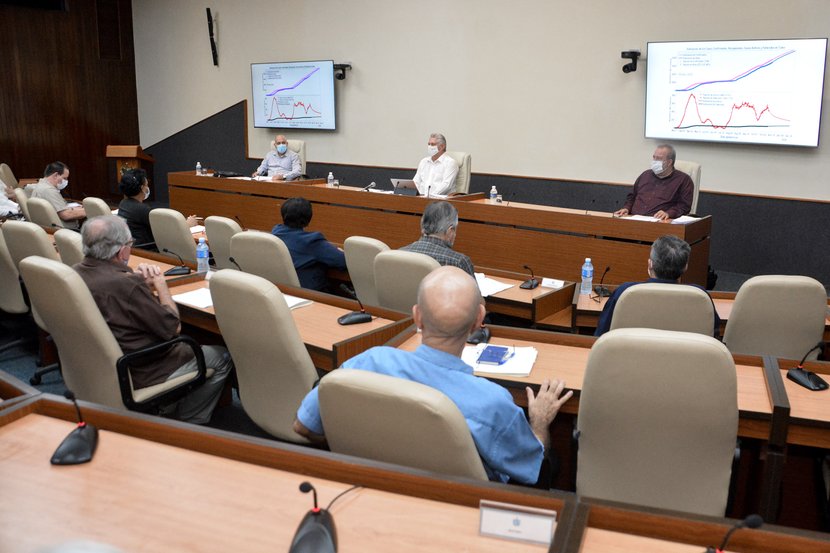Havana, Cuba: Cuba has contributed very much, and continues to do so, in the confrontation with COVID-19; ?We are not working only for ourselves, we are also working for the world?, Radio Reloj publishes.
This was recognized by the President of the Republic, Miguel Díaz-Canel Bermúdez, when leading a new meeting, from the Palace of the Revolution, with scientists and experts who for eight months have worked directly in the fight against the epidemic in the country.
The first moment of the session was dedicated to the analysis of the prognostic models of the behavior of the disease, a common point in these exchanges, in which the doctor of science Raúl Guinovart Díaz, dean of the Faculty of Mathematics and Computing of the University from Havana, commented on the current epidemiological scenario of the country and in particular on the four provinces that present a more complex situation at the moment: Pinar del Río, Ciego de Ávila, Sancti Spíritus and Havana.
Specifically regarding this territory, he pointed out that a complicated panorama has been maintained over the past week. It is expected – he said – that the number of cases will continue to grow, a reality that is associated with the current spread of the virus that exists in the province.
As a positive element, he highlighted that in the most recent seven days there has been an increase in the number of people recovered. According to the models, the peak of active cases has already passed, he pointed out.
Regarding Havana, he noted, that throughout the month of October and what has elapsed in November shows a very good control of cases, with a significant decrease, also of active patients.
However, he warned, in recent days there has been a slight increase in confirmed people, which should not be lost sight of because it is still impossible to know if this behavior is the beginning of a more complex moment of the disease or simply a alert to pay attention to.
The general estimate for Cuba – he said – is that the number of positive cases will continue to grow in the coming days and also the number of those recovered. Gradually the figures should begin to decline until reaching a plateau between 200 and 500 active cases, approximately, until the end of the year.
It is essential – he noted – to continue strengthening epidemiological measures, not only in the provinces that have cases, because mobility in the country grows and it may happen that the virus moves to other regions that do not have the disease at this time.
Epidemiology and modeling before Covid-19
A good part of the Government’s decisions regarding COVID-19 have been based on the contributions made by the Science Group, created to confront the epidemic in the country and as part of which the subgroup of Experts on Epidemiology and Modeling has carried out various useful research and innovations.
In this week’s meeting, where the Prime Minister, Manuel Marrero Cruz; Vice Prime Ministers Roberto Morales Ojeda and Inés María Chapman Waugh participated as well as the head of Public Health, José Angel Portal Miranda, an update was released on the main actions carried out from this important space in the course of these eight months.
From this work subgroup, explained the doctor of science Pedro Mas Bermejo, a work system has been developed that with the support of the University of Havana has led us to a constant learning process.
Among other objectives, during these eight months the members of the team have directed their actions fundamentally to contribute knowledge and scientific evidence to support decision-making by the Government and the national health system; mathematical modeling and forecasts to evaluate the behavior of the pandemic; epidemiological research, applying information technologies and geo-referenced systems; propose, develop and implement epidemiological tools; as well as designing indicators for the monitoring and control of the epidemic in Cuba.
Mas Bermejo also explained about the participation in different exchanges in international forums, in which Cuban experiences have been exposed and evaluated, and highlighted the publication of 27 publications, eight of them in international magazines.
Similarly, he referred to the development of statistical information and geographic information systems applied to epidemiological management, as well as to various forecasts of viral circulation, depending on the provinces and climatic conditions, and the strategy followed for the application of the biotechnology products in vulnerable settings and groups.
There have been many and diverse lessons learned in these difficult months in matters of preparedness, epidemiological surveillance, active research, diagnostic tests, biosafety, therapeutic interventions, lethality and equity, in the midst of which the Government’s management in interaction with scientists has encouraged the incorporation of all scientific production and human capital talent based on a common goal: control of the epidemic.
In this regard, President Díaz-Canel stressed the importance of granting greater visibility, both in Cuba and in the world, to the work of our scientists and researchers who have contributed so much to a small nation, with scarce resources and subjected to a ruthless economic warfare, today show indicators far superior to those of the so-called first world countries in the control and management of the disease.

